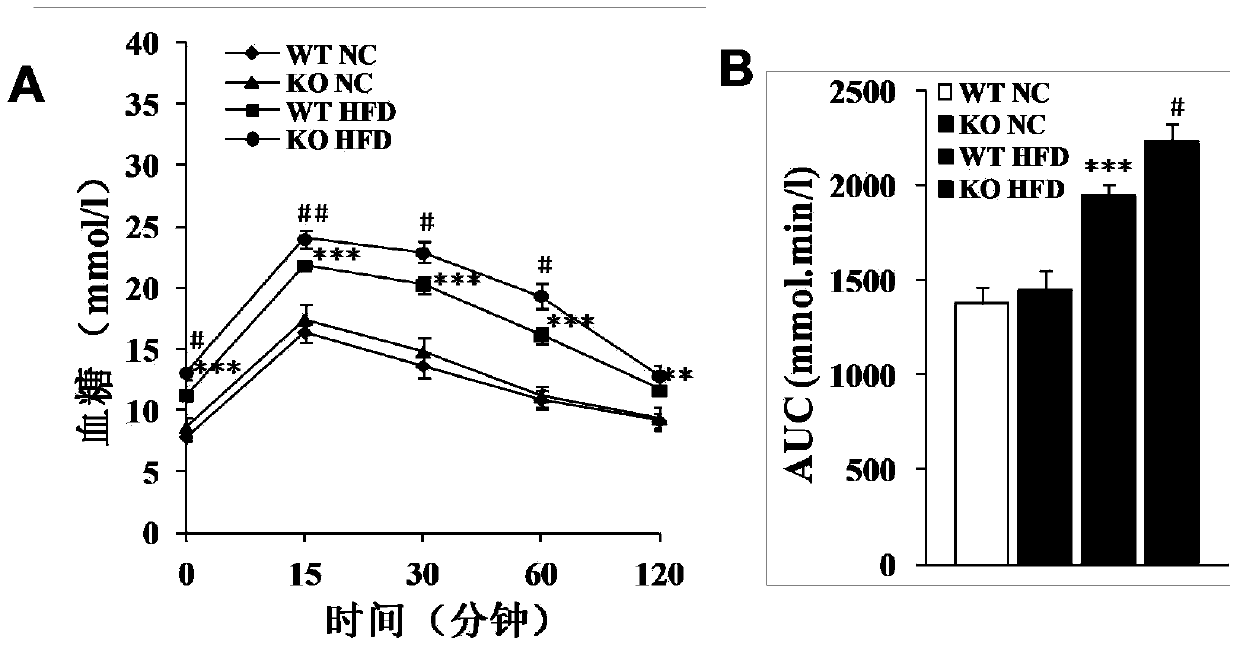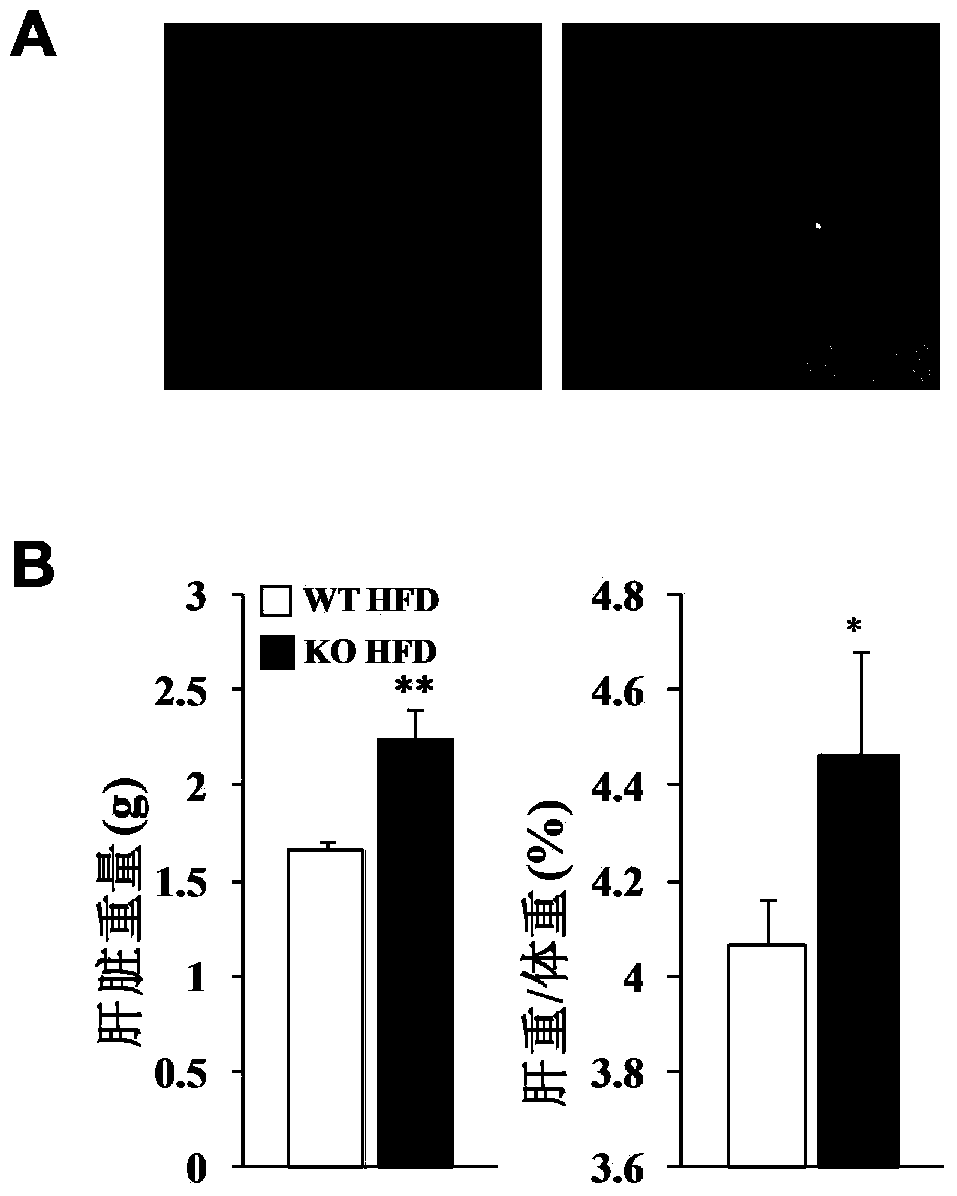Functions and applications of centrifugal force and shearing stress response gene 1 in fatty liver and diabetes mellitus
A shear stress and fatty liver technology, applied in gene therapy, metabolic diseases, pharmaceutical formulations, etc., can solve problems such as increasing blood volume, affecting insulin function, and increasing the burden on the heart
- Summary
- Abstract
- Description
- Claims
- Application Information
AI Technical Summary
Problems solved by technology
Method used
Image
Examples
Embodiment 1
[0050] [Example 1] Mouse fatty liver and diabetes model (DIO) obtained
[0051] 1. Grouping of experimental animals: 8-week-old, male, WT mice and RECS1KO mice were selected and fed with two special feeds, D12942 high-fat diet (Highfatdiet, HFD) and D12450B low-fat diet (Normalchow, NC), respectively, WTNC group, KONC group, WTHFD group, KOHFD group a total of 4 groups.
[0052] 2. Operation process of high-fat feed induction model:
[0053] Using WT and KO mice, the DIO model was established, and the phenotype correlation analysis was carried out to clarify that the RECS1 gene plays an important role in the pathogenesis of metabolic diseases. 8-week-old, male, WT mice and RECS1KO mice were selected and fed with two special diets, D12942 high-fat diet (Highfatdiet, HFD) and D12450B low-fat diet (Normalchow, NC), respectively, namely WTNC group, KONC group, WTHFD group, KOHFD group a total of 4 groups. The food intake of the mice was recorded in detail every week, and the fa...
Embodiment 2
[0054] [Example 2] Determination of body weight, blood sugar and insulin levels in fatty liver and diabetes model (DIO) mice
[0055] 1. Fasting body weight of mice, food intake detection, orbital sinus blood collection.
[0056] 1) Weight detection
[0057] ①Fasting: Fast the mice to be tested at 8:00 am (without water), and start the experimental operation at 2:00 pm.
[0058] ② Weighing: Weigh at 0 weeks, 4 weeks, 8 weeks, 12 weeks, 16 weeks, 20 weeks, and 24 weeks, put a small plastic bucket on a dynamic electronic balance, grab the mouse, put it into the weighing In the small bucket, measure the body weight and record the data. Feed amount detection: After the weighing operation is completed, add feed to the mice, and record the amount of feed for the mice on the dynamic electronic balance.
[0059] 2) Blood was collected from the orbital sinus after ether inhalation anesthesia, and the serum was separated.
[0060] ① Anesthesia: Put the cotton ball dipped in ether in...
Embodiment 3
[0093] [Example 3] Glucose tolerance test (intraperitonealglucosettolerancetest, IPGTT)
[0094] On the 22nd week of the experiment, the intraperitoneal glucose injection test (IPGTT) was performed to evaluate the glucose tolerance of the mice.
[0095] ① Before measuring blood glucose, measure the fasting body weight of the mice, and calculate the injection volume of glucose based on 10 μL / g.
[0096] ② First test the fasting blood glucose at 0 minutes before the glucose injection, and inject the glucose solution through the abdominal cavity quickly after the test is completed.
[0097] ③Operation method of intraperitoneal injection: (1) Fix the mouse; grab the mouse, grasp the tail of the mouse with the little finger and ring finger of the left hand, and grasp the neck of the mouse with the other three fingers, so that the head of the mouse is downward, and the The abdomen of the mouse is fully exposed. (2) Needle positioning and injection: Insert the needle from the side ...
PUM
 Login to View More
Login to View More Abstract
Description
Claims
Application Information
 Login to View More
Login to View More - R&D
- Intellectual Property
- Life Sciences
- Materials
- Tech Scout
- Unparalleled Data Quality
- Higher Quality Content
- 60% Fewer Hallucinations
Browse by: Latest US Patents, China's latest patents, Technical Efficacy Thesaurus, Application Domain, Technology Topic, Popular Technical Reports.
© 2025 PatSnap. All rights reserved.Legal|Privacy policy|Modern Slavery Act Transparency Statement|Sitemap|About US| Contact US: help@patsnap.com



